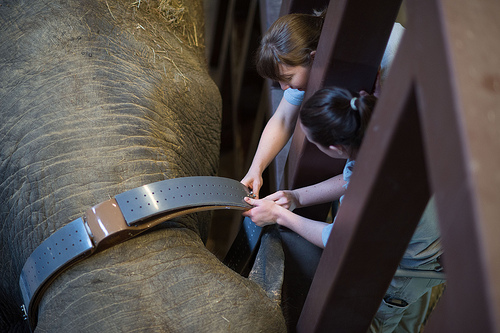Partners in the Sky: Aviation and Aerospace Industry Leaders Join The Smithsonian In Worldwide Conservation Efforts
Partnership Will Revolutionize Animal Tracking
Unlocking the mysteries of animal migration through precise, near real-time tracking can solve major conservation challenges and transform wildlife science worldwide. For the past year, scientists at the Smithsonian Conservation Biology Institute have been working with aviation and aerospace leaders, led by Airbus to launch the Partners in the Sky" program using aviation and aerospace technology to create a first-of-its-kind global animal-tracking system.
"By bringing together the scientific expertise of the Smithsonian with this roster of partners and their technological assets, we will take a quantum leap forward in our understanding of migration and make a real and lasting impact on biodiversity," says Steve Monfort, director of the Smithsonian Conservation Biology Institute. "Our Partners in the Sky initiative is an example of the public and private sectors sharing responsibility to take on a worldwide conservation challenge."
Allan McArtor, chairman of Airbus Americas, learned of the technical challenges facing scientists tracking animals and knew industry could provide solutions. "Aviation and aerospace companies deploy similar technologies and programs every da--whether in satellite navigation, communication and surveillance or in high-fidelity tracking," said McArtor. "No industry is better positioned to help the public sector transform wildlife conservation and make a difference in the health of our planet."
Movement of animals is essential to maintaining ecosystems and ultimately a healthy planet. Migrations are common among more than 6,000 species and occur almost everywhere in the world, often spanning thousands of miles. More than 90 percent of the globe's wildlife is too small to track. For larger species like elephants, conservation-tracking technologies are prohibitively expensive, have high failure rates and are limited in range and resolution.
SCBI scientists are leaders in studying animal movement and its consequences for species, communities and ecosystems. A comprehensive tracking program that SCBI can share across the conservation community has enormous potential. Integrating that information with key environmental and satellite data from other sources, potentially through one platform, will help scientists pinpoint what drives animal movement. The worldwide conservation community could track animals over their lifetime, discover unknown migration routes, understand the spread of infectious disease, reduce human-animal conflicts, combat poaching, pinpoint the root causes of migratory bird population declines and save species from extinction.
SCBI scientists identified specifications for the ideal tracking system and presented them to the Partners in the Sky consortiu--Airbus, Intel, Iridium Communications Inc., Joubeh, Lockheed Martin, Michael Goldfarb Associates, Raytheon, Rockwell Collins and United Airlines. Pennsylvania State University's Applied Research Laboratory joined the effort thanks to a donation from the Rick Bowe and Karen Nemeth Charitable Fund. Together with the Partners and Penn State's ARL, SCBI scientists charted a course of action that includes four key parts:
- The 1 Gram Challenge. Miniaturizing tracking devices to 1 gram or less will help pinpoint precise movement of birds and other small migratory animals, like amphibians remotely. Existing devices are too large and heavy to track small animals. A tracking device should not weigh more than 5 percent of an animal's total body weight to minimize impact on the health of the animal.
- Satellite Technology. Industry and scientists are working together to increase data transmission and make tracking devices more affordable and reliable, ideally lasting the lifetime of an animal. Increasing the use of low-orbit satellite networks will help track animals anywhere in the world at any time.
- Commercial Aircraft. Aircraft equipped with antennae and receivers will collect tracking data from transmitter-tagged wildlife on passenger routes and automatically download information to users on the ground. Partnering directly with commercial airlines to use existing transmitters and leverage a network of this scale is unprecedented in animal tracking.
- Big Data. By integrating tracking with environmental satellite data, scientists will be able to predict why, how, where and when animals move. These movement models can reveal connections between important conservation issues, such as climate effects on animal movement, infectious disease spread and human-wildlife conflict. Together with the Partners, SCBI will explore working with existing wildlife programs to integrate tracking data into one comprehensive platform.
The Partners in the Sky program is still in its beginning stages: expanding the markets to make the satellite solution affordable; developing high-power, 1 gram tracking devices; engineering, building, and certifying aircraft antenna to pick up tagged wildlife on overfly routes.
To showcase the potential of the technology, the Zoo's Asian elephant Shanthi and elephants in the wild at the Centre for Conservation and Research in Sri Lanka, have been collared with tracking devices. Using the Iridium satellite constellation, their positions will be displayed on a kiosk at the Elephant Community Center and on the Zoo's website. Position reports from three recently tagged black-crowned night herons will also be included, marking the first time that scientists will know the migratory route and winter destinations of these birds after they leave the National Zoo each summer. An "Animal Trax" module will be integrated into the Zoo's existing App in early 2014. Through "Animal Trax," users can keep track of the movements of their favorite animal.

